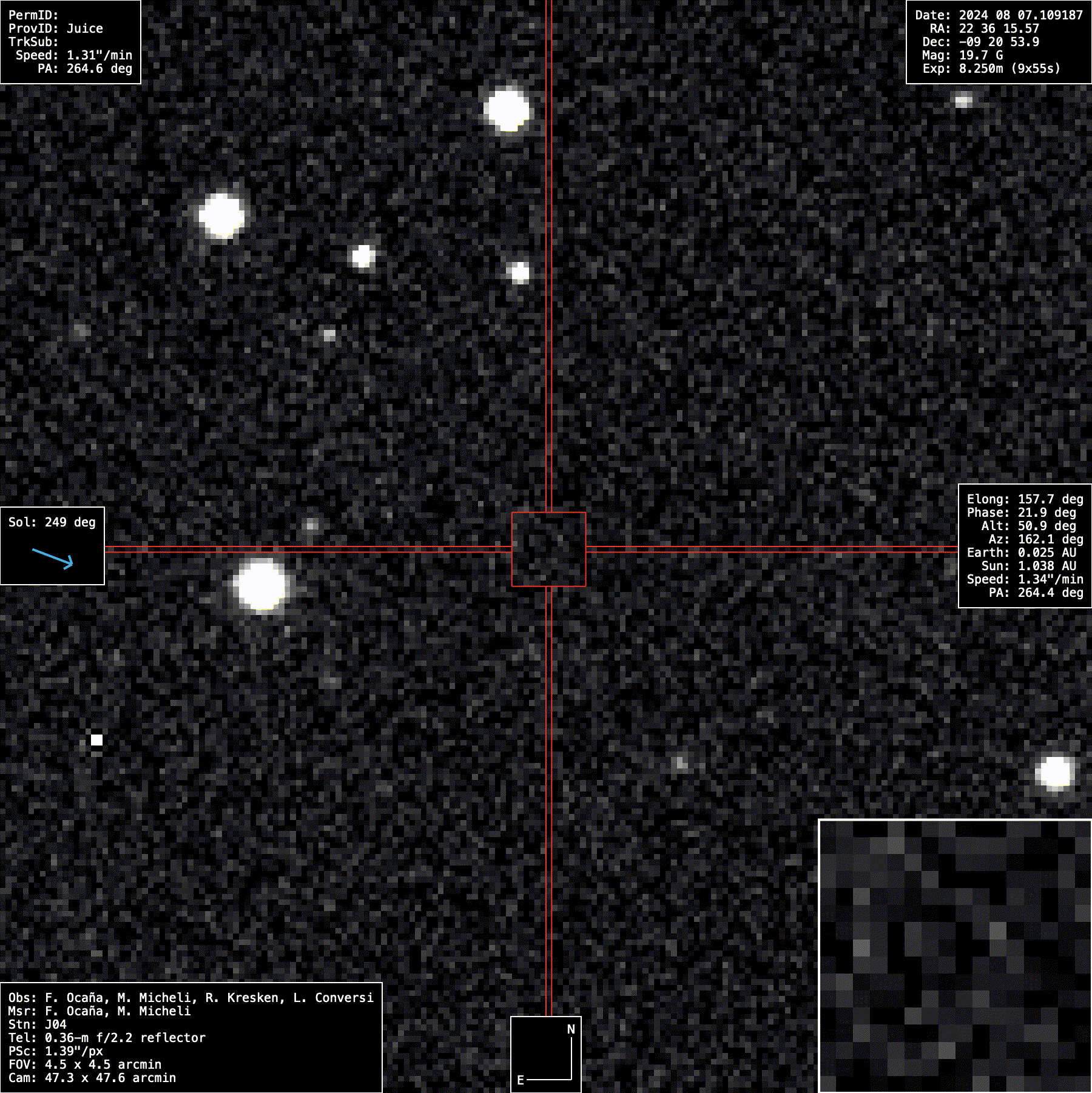On 6 July, a previously undetected object triggered the automated warning systems that alert the global planetary defence community of a new potentially hazardous asteroid. The object, estimated at around 50 m in diameter, was spotted hurtling towards Earth on a path that would take it uncomfortably close to the Moon and our planet.
But thankfully, this was no asteroid.
Instead, the automated ESA and NASA warning systems had picked up a much more well-intentioned visitor – ESA’s Juice spacecraft!
Juice is a big spacecraft but certainly nowhere near 50 m across – so why did Juice appear to be so large? Astronomers determine the size of a near-Earth object such as an asteroid or a comet using its brightness. These objects are typically made of fairly dark, rocky material, and so they need to be quite large to reflect lots of sunlight. Due to the much higher reflectivity of Juice’s large solar arrays, its brightness was similar to that of a much larger asteroid.
Let’s take a look at a few views of Juice in the night sky.
This is how Juice appeared on Wednesday 7 August to ESA’s Optical Ground Station in Tenerife, Spain. We see Juice as a white dot that moves from left to right through the red box.

A few days earlier, on 3–4 August, ESA astronomers used the 80 cm Schmidt telescope at CAHA observatory in Spain. The resulting image (below) shows Juice moving from left to right across the centre of the frame.
Just above Juice is another dot moving from left to right – this is actually a distant asteroid that just happened to be aligned with Juice! The Schmidt telescope is routinely used by ESA’s Planetary Defence Office to spot and track asteroids. There are plenty more asteroids in this GIF, all appearing as white dots moving left to right.

It’s not only ESA telescopes keeping an eye on Juice. The images below were taken by one of the ATLAS NEO survey units in Hawai’i. ATLAS is an asteroid impact early warning system developed by the University of Hawaii and funded by NASA. It consists of four telescopes that automatically scan the whole sky several times every night looking for moving objects. The ATLAS team have observed Juice several times over the last few weeks.

In all these views, Juice appears to move slowly across the field of background stars because the spacecraft is on track for its upcoming lunar-Earth flyby and so is currently heading almost directly towards us.
Fortunately, planetary defenders have confirmed that Juice poses no risk to Earth (?), and there continues to be no known asteroid on course to collide with our planet for at least the next 100 years.
Juice is now just four days away from its lunar-Earth flyby, which will use the gravity of the Moon and Earth in quick succession to slingshot the spacecraft towards Venus for its next flyby in August 2025.
Find the information you need to try and spot Juice yourself here – but it won’t be easy!

Discussion: 8 comments
Be glad that it’s not an asteroid or a comet.
There are many abbreviations in the JUICE timeline tool that I cannot decipher, e.g, MGG, 74T, 74H, EPE, S3B, etc. Any help to better understand the used abbreviations would be greatly appreciated.
Some of them are completely false, while the rest of them are completely true. Does this answer your understanding?
Okay — No!
Whew
By the way, can somebody tell us something about the JUICE Monitoring Unit (JMU)? A 2018 publication mentions that among other things the unit evaluates the micro-meteorite damage on the solar generator panels. The working principles of these measurements would be interesting.
First of all, congratulations for the successful lunar flyby ??
What are the circular moving dot patterns in the image?
E.g. in the upper left corner here: https://blogs.esa.int/rocketscience/files/2024/08/Juice-002.gif
Best regards,
Oliver
The circular moving dots are image artifacts called hot pixels. These pixels are damaged and only give a constant value. The animation has been made from hundreds of individual frames. Between the frames, the telescope is moved slightly with respect to the stars. This so called “dithering” makes the ccd-fixed hot pixels move in an elliptical pattern.